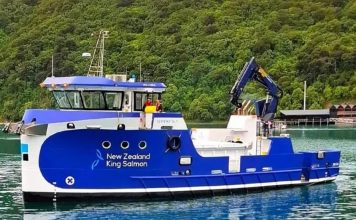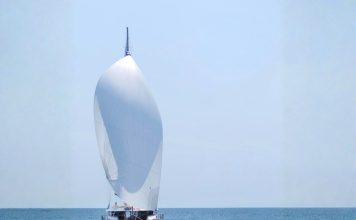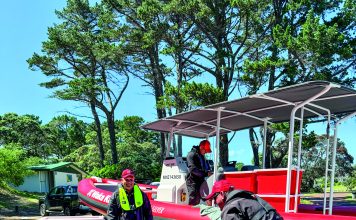Assault Boats’ new Pursuit 920 Amphibious is a great all-rounder. Suitable for fishing, scuba diving, family cruising, overnight trips, corporate hospitality – even search and rescue operations – it’ a spacious, comfortable, and stylish package that is very simple to operate and drive.
The extreme deep-vee hull and wide pontoons are capable of handling the roughest of sea conditions, while the spacious cabin with generous berths provides shelter from all weather. The powerful Yamaha F350 outboard with digital steering and controls is super quiet and easy to use, and despite the overall weight of the boat, this provides very good performance. The 400-litre fuel tank combined with the efficiency of the motor provides an extensive range, making it suitable for long offshore game fishing or extended overnight trips.
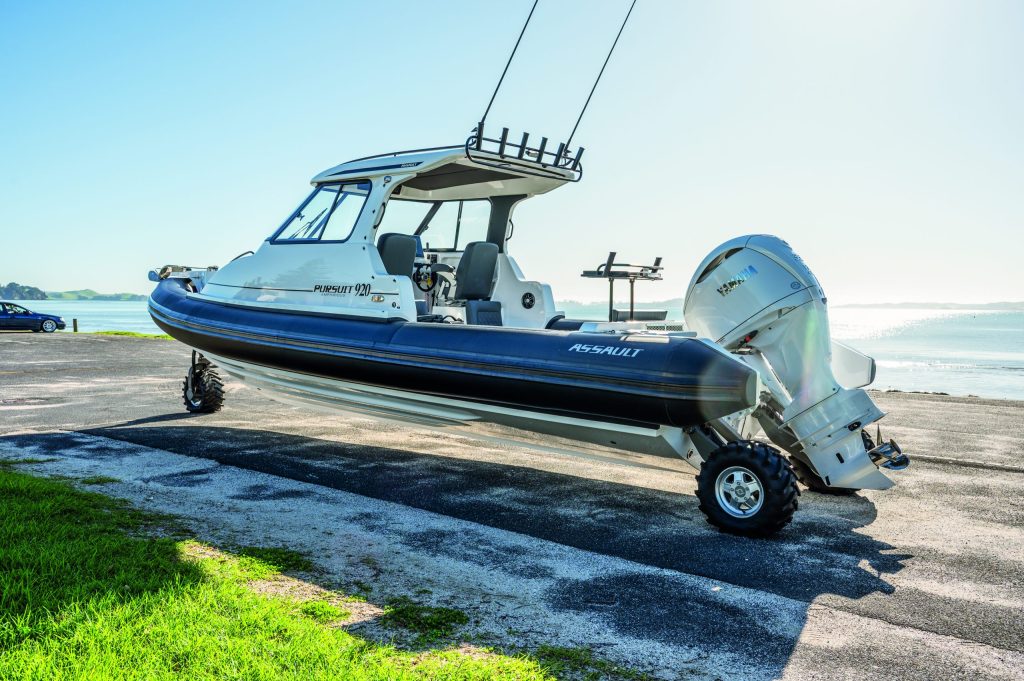
And then for good measure, Assault has added the amphibious capability from Anura. This technology is a game-changer for some people, like a recent purchaser who had just sold his previous boat. In his senior years, he told Mark Taiatini of Family Boats that he no longer had the strength and agility to get his boat onto a trailer at the end of the day. The purchase of the Assault 920 Amphibious has given him another 10 years or more of boating, since he now has a big, fast, and stable boat that he can single-handedly drive out of the water at his boat club and simply park in its designated spot.

And that simplicity of operation is probably the defining characteristic of the Assault. Its 9.4m length and 2.9m beam mean it has lots of interior space with a clean and no-fuss layout. The boat is configured as an open cabin, with luxury king and queen seats on either side. The fixed footrests are at a comfortable height but have the potential to be shin hazards – one of the very few negatives we found on this boat. Behind them in the wide-open cockpit is another forward-facing folding bench seat up against the transom, while an ingenious removable folding baitboard can be discreetly packed away when fishing is not on the cards. Similarly, a plumbed-in live bait tank can be disconnected and hidden away when not required.
Although the transom does not have a walk-through, it is easy enough to step over onto the wide stern platform for fishing or swimming. Those big pontoons create wide and comfortable seats all around while also providing secure thigh support for leaning against. A wide boarding ladder curves up over the port pontoon, although Mark says that one customer uses the hydraulics of the wheel mechanism to provide a powered swimmer’s lift when needed.
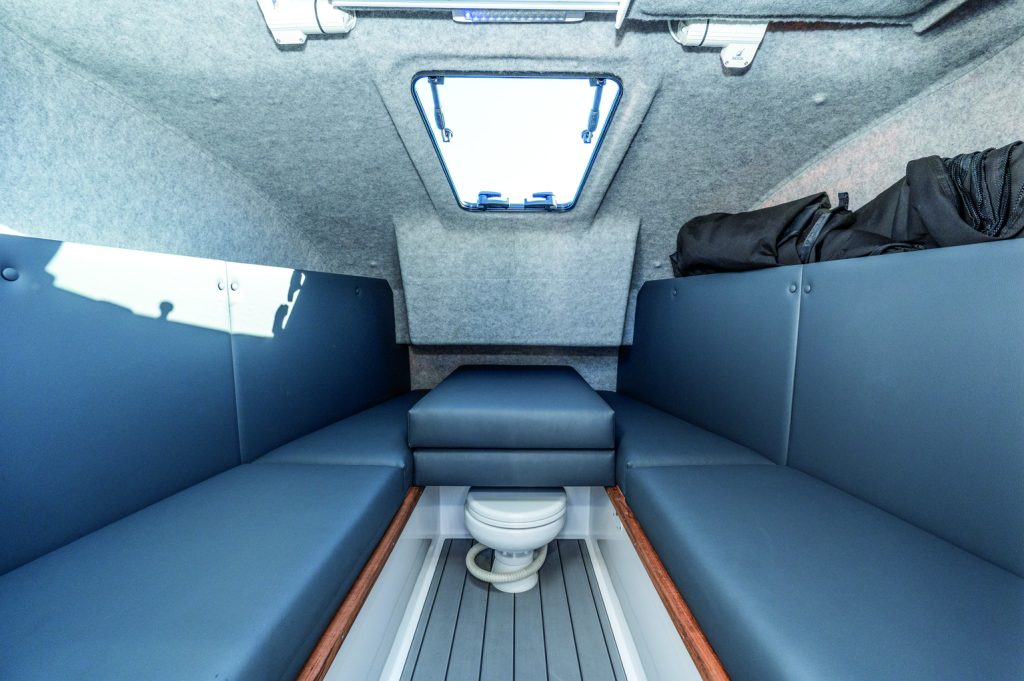
Inside the forward cabin is a very generous berth, providing twin bunks without fitting the insert and three berths when it is installed. Underneath is a plumbed toilet. Although this boat was not configured with a galley, freshwater, or refrigeration options, there are ample places for these accessories to be installed in the seat pedestals or transom area.
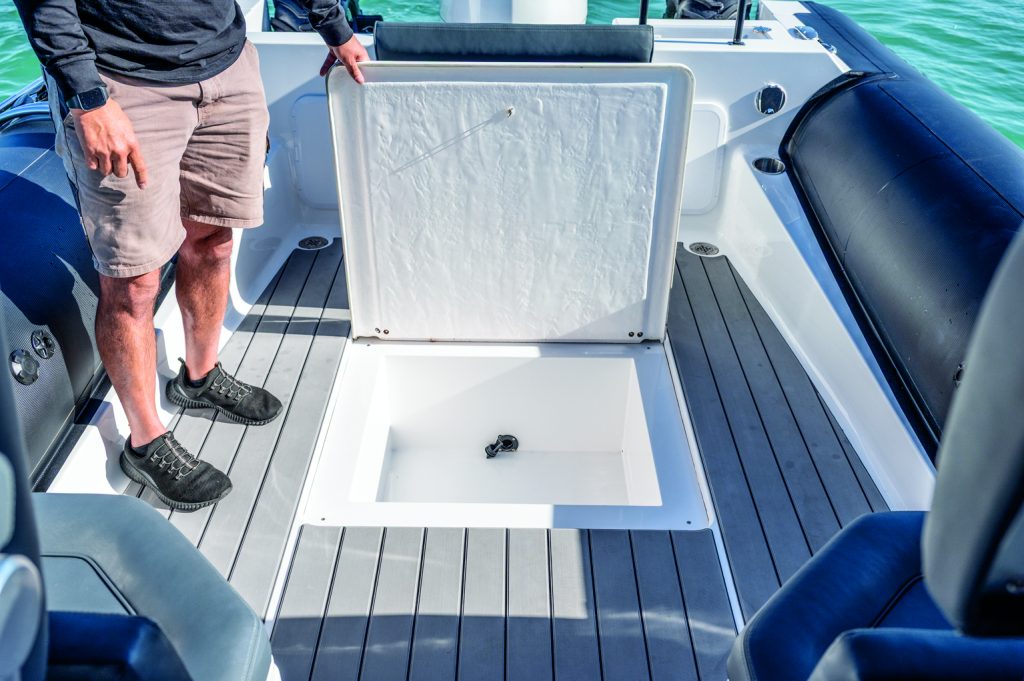
Another nice feature that is only possible on a boat of this size is the forward deck area, which forms a separate hospitality zone. Another twin bench seat, backing onto the main cabin, provides a bowrider capability, and this is also a great place for rowdy teenagers to have their own space. Access is through
a forward hatch in the cabin or around the sides of that cabin, with sturdy grabrails to provide a secure pathway.
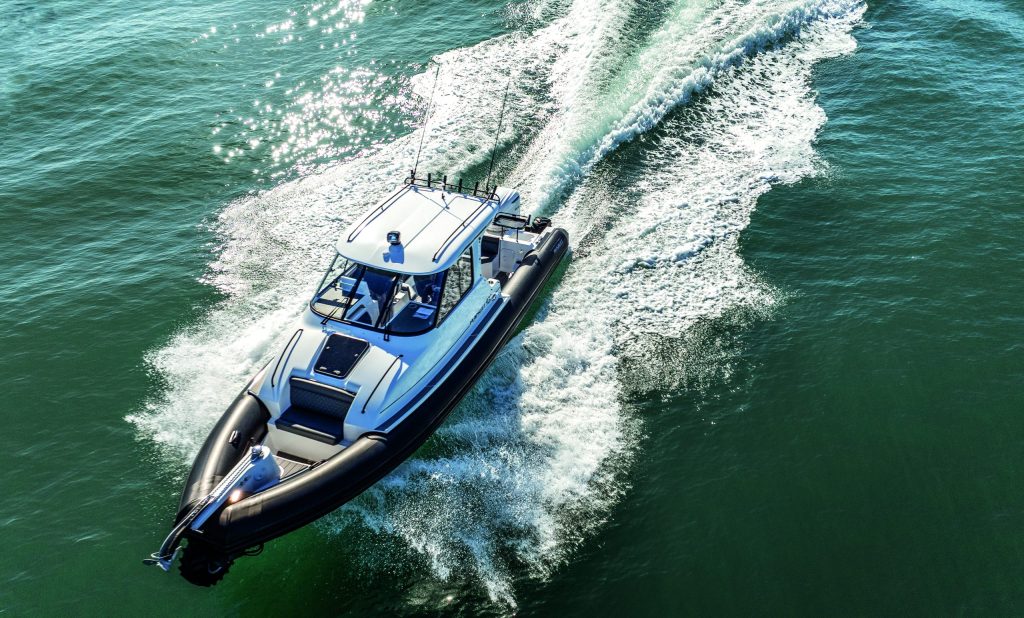
The bowsprit and fairlead on this model are pretty chunky, since they need to accommodate both the front wheel mechanism and the anchor winch. The anchor is held clear of the wheel and pontoons, and neither of these intrude into that forward space. There is no bow rail, but the recessed deck and pontoons on the sides provide security for anyone in the forward area.
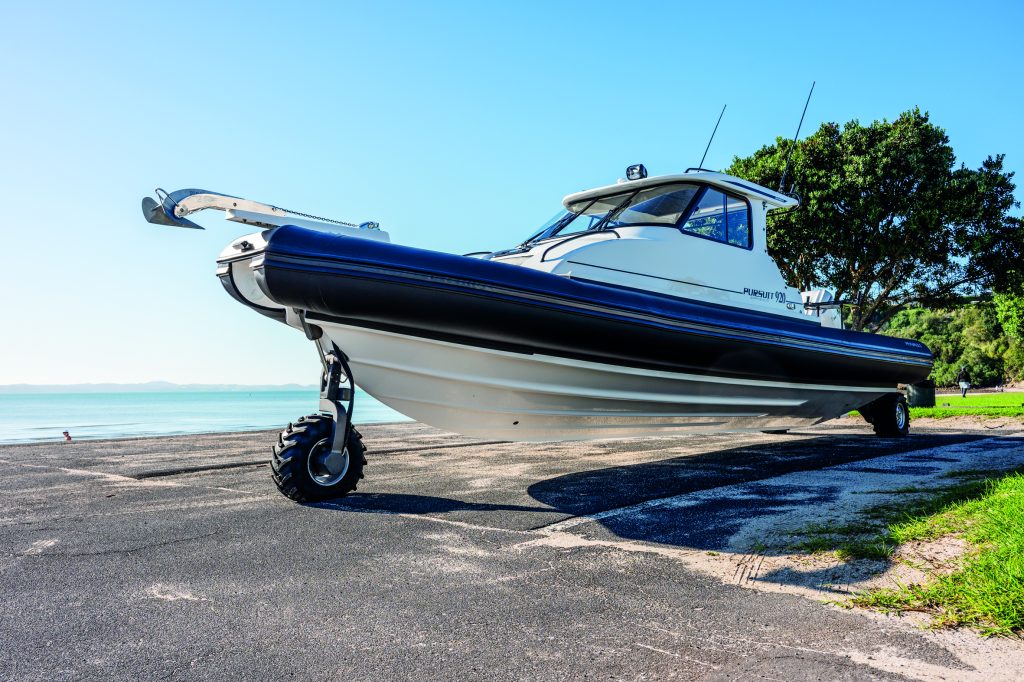
Once we had taken a few photos on the beach, it was time to launch. Driving the Anura system is simplicity itself, with just two control units. One panel of switches is used to control the 40hp air-cooled motor, as well as deploying or retracting the wheels. The second joystick applies power to the wheels, and this can be varied between just the front wheel or all-wheel drive. One of the drawbacks of an air-cooled motor is that it makes a fair bit of noise, but the quieter all-electric Anura drive is available as an option.
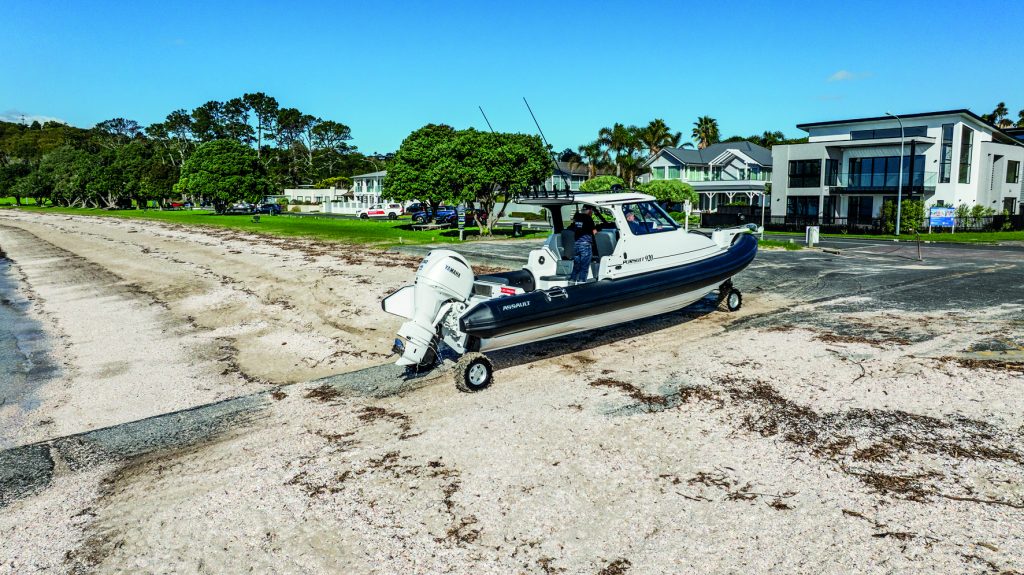
Steering of the ground wheels is through the same steering wheel as the Yamaha outboard, and a camera tucked under the fairlead allows a view of how the front wheel is tracking. All engine parameters are displayed on the main Garmin 16-inch multifunction display, and a separate Yamaha CL5 digital display, as well as CZone digital swich control and the Anura engine display, are located in the brow of the hardtop. After starting the Anura system, we drove down the beach and into the water, where Mark started the whisper-quiet Yamaha 4.3 litre 350hp outboard.
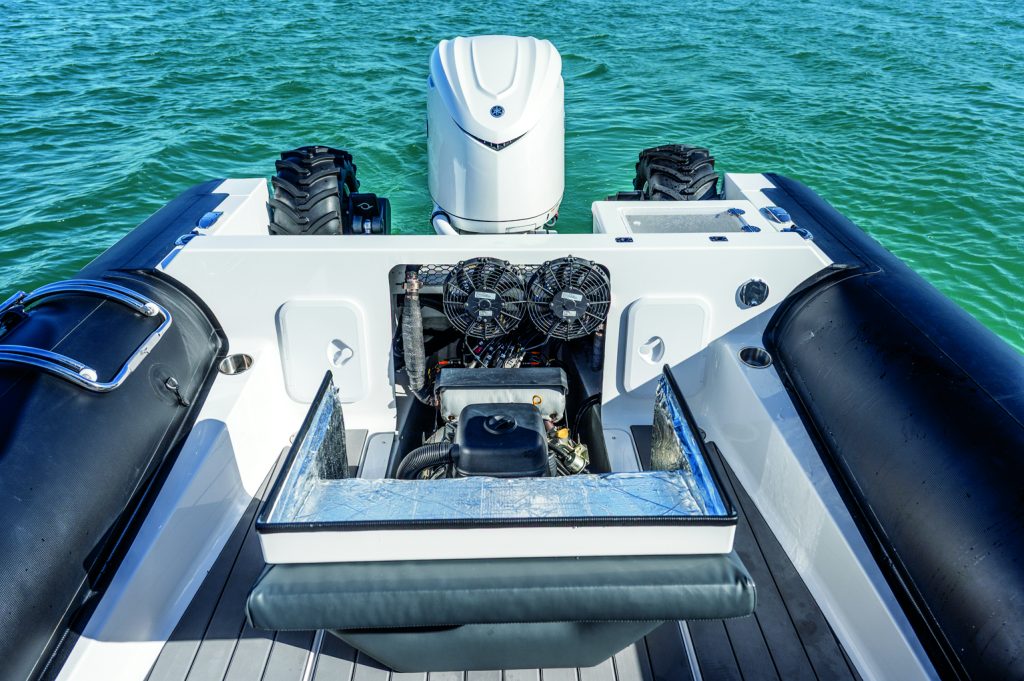
This is the very latest iteration of the Yamaha V6 Offshore series. This completely new model increases the displacement and power of the 4.2-litre version to give the same horsepower while weighing substantially less than the old 350hp V8. Every part of this motor has been upgraded to optimise power and performance while retaining the legendary Yamaha reliability and durability. A new cowling shape and trim help identify the new model, while the digital steering with its 32o swing to either side together with a higher tilt angle are the only other subtle but apparent differences.
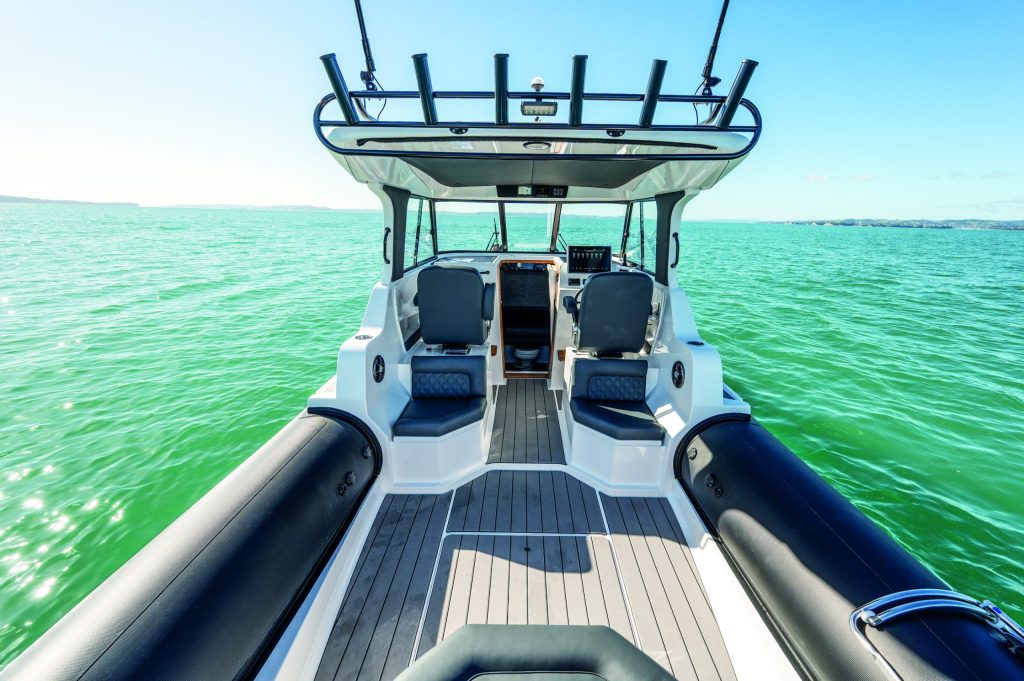 The hull has an extreme deep vee of 25°, made possible thanks to the counteracting stability provided by those big pontoons. This truly gives the best of both worlds in terms of handling – the hull geometry is fast, she cuts easily through wakes without any hard landings and, thanks to generous planing strakes, was also stable at high speed even when we moved about.
The hull has an extreme deep vee of 25°, made possible thanks to the counteracting stability provided by those big pontoons. This truly gives the best of both worlds in terms of handling – the hull geometry is fast, she cuts easily through wakes without any hard landings and, thanks to generous planing strakes, was also stable at high speed even when we moved about.
The boat did not have any trim tabs fitted, and we found no reason to think these would be needed. When turning hard, the inward tube comes down to the waterline, ensuring the boat always feels superbly stable. And those big pontoons keep spray well away from the inside of the cabin. This is truly a boat that you could not drive badly – it will absorb the most ham-fisted handling without a hitch, remaining safe and inspiring confidence.
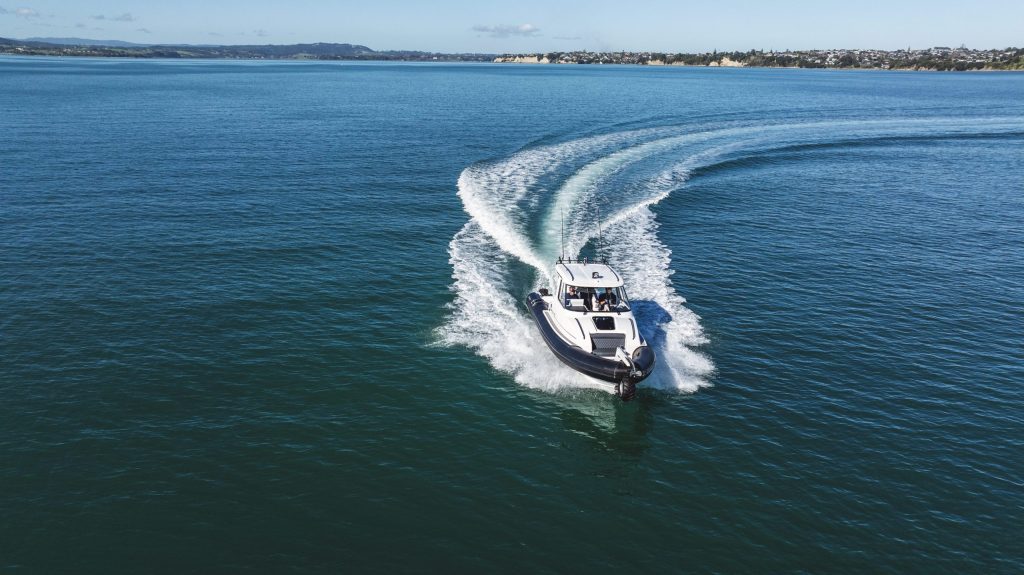
The other half of the stability equation is when travelling at low speeds or while completely at rest, and here the big pontoons come into play. The hull settles down onto them so the full beam provides stability, creating a comfortable platform with absolutely no tendency to lean. At lower to medium RPM the motor could hardly be heard, although at full throttle, of course, the open cabin means the otherwise pleasant sound of the engine is dominant.
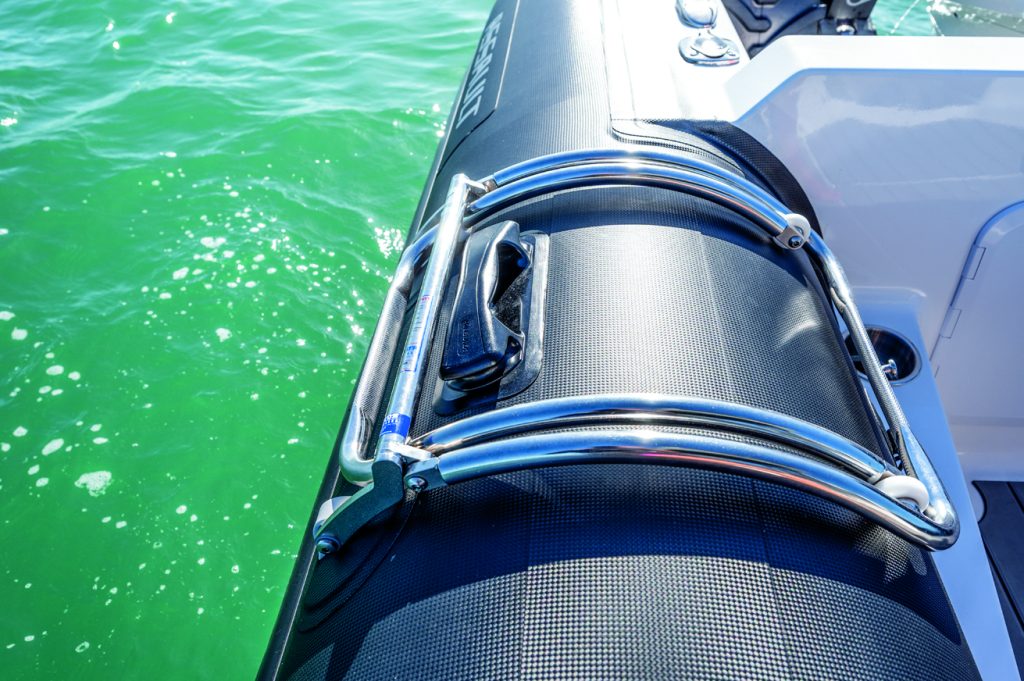
Using the digital steering system is fantastic, with the extremely soft and responsive steering and throttle. The Helmaster EX system combines GPS and autopilot capability to allow features like FishPoint, which will hold the boat in one position no matter what the wind or current is doing.
Using the joystick control makes manoeuvring around a tight marina effortless, despite only having a single engine. Moving the joystick to one side will enable the boat to ‘crab’ in that direction by swinging the motor and alternately engaging forward and reverse. This enables one to single-handedly bring the boat alongside a wharf even with other boats on either side, completely eliminating ‘parking anxiety.’
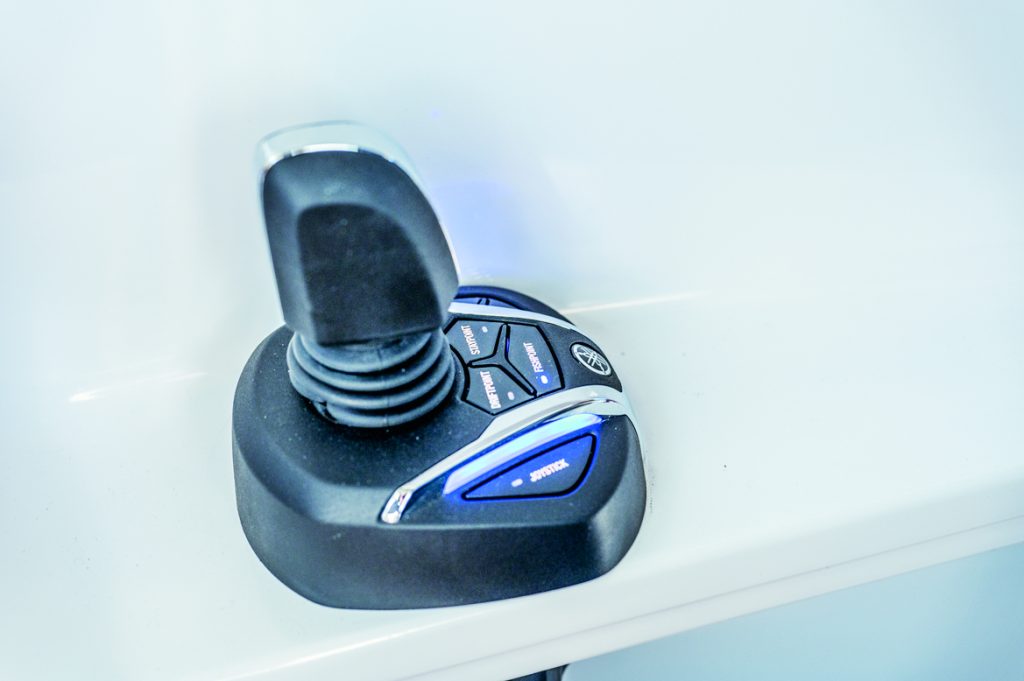
Pushing the throttle hard down was gratifying, with 38 knots coming up on the GPS at 5,600rpm. At this speed she was gulping 2.8 litres per nautical mile, by no means excessive for a boat weighing in at about 2.8 tonnes. At a normal cruise speed of between 25 and 30 knots, her consumption dropped to 1.9 litres per nautical mile, and she has an almost flat consumption curve throughout the mid-range, from 3,000 to 4,500rpm at speeds between 15 and 30 knots.
All too soon we had to head back, and she drove up and along the beach without difficulty. We could climb off without getting our feet wet, after which Mark simply drove up onto the trailer before settling the big boat down for her trip back to the showroom. If necessary, the pontoons can be deflated to bring her inside over-width towing limit regulations.
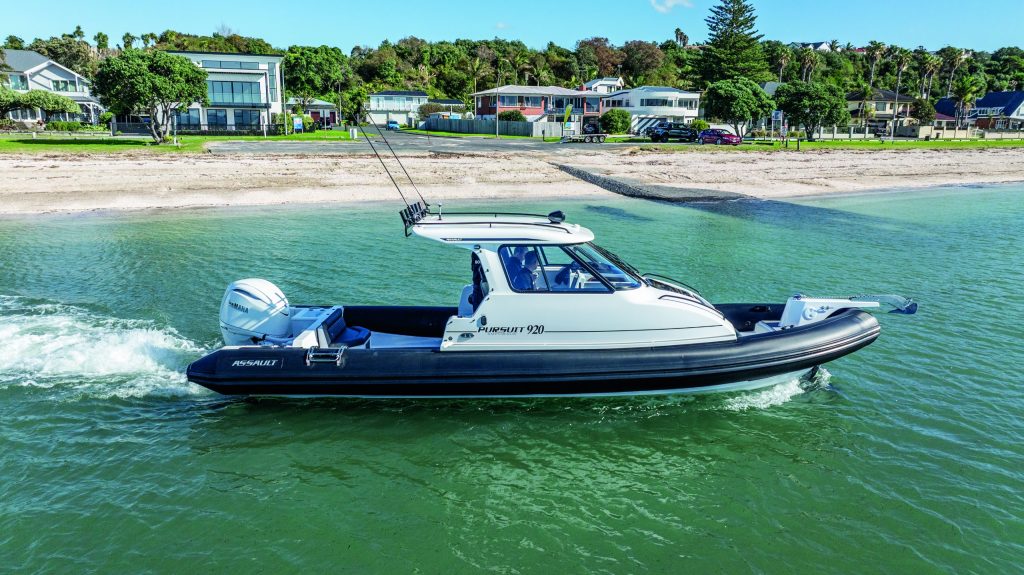
The styling of the Assault 920 is modern yet with a traditional European look rather than radical, which means she won’t draw too much attention apart from when she drives up the beach. But this also means she has wide appeal, which combined with her versatility, makes this a hugely attractive model. The size and amphibious features certainly push the price up into the upper reaches of the trailer boat market, but she truly is a boat that would suit nearly everyone. It is a boat I would love to own!








